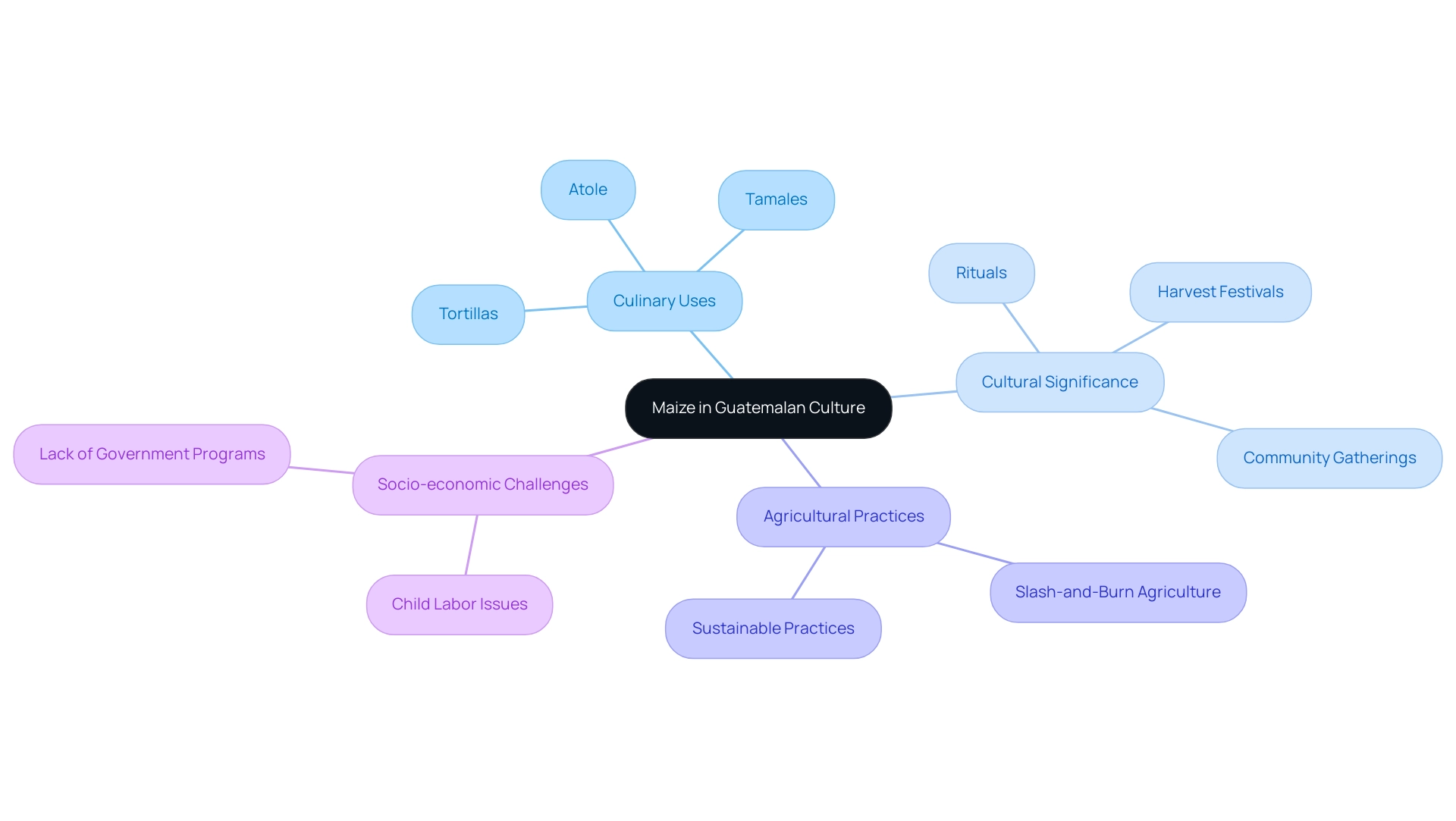Overview
Get ready to embark on a culinary adventure in Guatemala! This country’s vibrant food scene is a thrilling fusion of indigenous traditions and Spanish influences, where staple ingredients like maize, beans, and chilies take center stage! Each dish not only celebrates the rich, local ingredients but also tells the fascinating historical and cultural stories of Guatemala! Every meal is an exciting journey waiting for both locals and visitors to savor! So, pack your bags and prepare to dive into the delicious world of Guatemalan cuisine—it’s an experience you won’t want to miss!
Introduction
Get ready to embark on an exhilarating journey through Guatemala’s culinary heritage—a vibrant fusion of history, culture, and tradition that offers a tantalizing glimpse into the soul of this incredible nation!
With roots tracing back to the ancient Maya civilization, the food scene here is a colorful mosaic of indigenous ingredients and Spanish influences, showcasing the unique flavors that define Guatemalan cuisine!
From the revered maize that forms the backbone of countless dishes to the communal dining customs that foster connections among families and friends, every bite tells a story bursting with flavor and tradition!
As chefs innovate while honoring traditional recipes, the culinary landscape continues to evolve, inviting both locals and travelers to partake in an extraordinary gastronomic adventure!
This exploration of Guatemala’s rich culinary tapestry reveals not only delicious dishes but also the cultural significance that food holds in the lives of its people—so come and savor the excitement!
Exploring the Rich Culinary Heritage of Guatemala
Guatemala’s culinary landscape is a vibrant tapestry woven from its rich history, indigenous traditions, and the exciting influences of Spanish colonization! The dynamic foods of Guatemala reflect the diverse ethnic groups that inhabit the region, each contributing unique flavors and cooking techniques that enrich this gastronomic adventure! Traditional cuisine here relies heavily on fresh, local ingredients, with a strong emphasis on staples like maize, beans, and chilies, making every meal a celebration of culture and identity!
These ingredients are not just staples; they symbolize sustenance and cultural identity, playing a crucial role in the daily lives of Guatemalans! Maize, revered as a sacred crop, is integral to various traditional dishes—from tamales to tortillas—making it a cornerstone of Guatemalan cuisine. Beans enhance maize in numerous delicious ways, offering vital nutrients, while chilies add depth and flavor, showcasing the region’s culinary creativity!
But wait, there’s more! Culinary practices in Guatemala extend beyond mere sustenance; they are deeply rooted in cultural rituals and community gatherings! The foods of Guatemala play a central role in social life, bringing families and communities together to celebrate traditions and share stories! Picture lively markets and local restaurants filled with the enticing scents of traditional meals, inviting both residents and tourists to indulge in [this rich gastronomic experience](https://eliteplusmagazine.com/Article/1080/ Guatemalan_Cuisine__A_rich_tapestry_of_gastronomic_traditions)!
And guess what? Recent advancements in Guatemalan cuisine emphasize a rising respect for the country’s heritage! Cooks in the capital are crafting high-end, contemporary adaptations of traditional dishes, merging innovation with time-honored recipes! This evolution reflects a broader trend in the food world, where the revival of indigenous food traditions is gaining momentum, creating a deeper connection between the past and present!
In fact, Guatemala City boasts [a growing fine dining scene](https://eliteplusmagazine.com/Article/1080/ Guatemalan_Cuisine__A_rich_tapestry_of_gastronomic_traditions) where chefs are redefining traditional cuisine, showcasing the dynamic nature of modern culinary experiences from the region! As Shirley Aguilar, HE Ambassador, aptly summarizes, “the foods of Guatemala in modern cuisine reflect a dynamic culinary scene that honors tradition while embracing innovation and creativity!”
Case studies exploring indigenous food traditions reveal how these practices are not only preserved but celebrated! For instance, the integration of traditional cooking methods in contemporary dining experiences showcases the resilience and adaptability of Guatemalan cuisine! Drawing parallels with Hanoi’s Old Quarter, which exemplifies how historical and [cultural elements create engaging travel experiences,](https://eliteplusmagazine.com/Article/1080/ Guatemalan_Cuisine__A_rich_tapestry_of_gastronomic_traditions) it becomes clear that honoring indigenous traditions remains paramount in the region!
This ensures that the rich heritage of the country is both recognized and cherished, inviting you to embark on this delicious journey!
Must-Try Traditional Dishes: A Culinary Tour
A visit to Guatemala is an adventure waiting to unfold, and it’s simply incomplete without diving into the must-try traditional meals that showcase the incredible flavors of the country’s rich culinary heritage! At the forefront is Pepin, often celebrated as the national specialty! This robust stew combines tender chicken with a medley of vegetables and a distinctive blend of spices, creating a flavor profile that is both hearty and comforting!
But wait, there’s more! Kak’ik, another iconic meal, is a vibrant turkey soup that highlights the use of local herbs and spices, delivering a spicy kick that varies by region and family tradition! Other noteworthy options include Jocón, a refreshing green chicken stew made with tomatillos, and Fiambre, a colorful cold salad traditionally served during the Day of the Dead celebrations! Each of these meals not only tantalizes the palate but also recounts the stories of the country’s diverse history and cultural influences!
And let’s not forget Gallina en kaq’ik, acknowledged as a national meal! This spicy turkey stew has been honored for its cultural importance, earning the designation of Cultural Heritage by the Ministry of Culture and Sports in 2007! It exemplifies the regional variations and family recipes that make Guatemalan cuisine so distinctive!
Food experts rave about the richness of Guatemalan fare, reflecting the vibrant culture and traditions of the country! For those embarking on a gastronomic journey in 2025, these traditional meals are vital experiences that will undoubtedly enhance your admiration for the local craftsmanship and culture! Additionally, Mole platano, with its fried plantain slices in a chocolate-based sauce made with several chilies, is an absolute must-try for its unique flavor combination!
Throughout the country, you can find handmade cacao, chocolate, and drinks, especially in regions like Corn and Verapaz, as noted by writer Ana Pereira! Plus, items like Tamalitos de masa, patches made from potatoes, and bollitos filled with beans showcase the variety of traditional foods available, enriching the culinary experience for every visitor! Get ready to explore and indulge!
The Role of Maize: A Staple in Guatemalan Cuisine
Maize, or corn, is so much more than just a staple food in Guatemala; it embodies the very essence of life and cultural identity! This vital crop has been cultivated for millennia, tracing its roots back to the ancient Maya civilization, where it was not only revered as a food source but also celebrated as a symbol of sustenance and community. In 2025, maize consumption remains a cornerstone of Guatemalan diets, with over 90% of households incorporating maize into their daily meals!
In the vibrant foods of Guatemala, maize shines in a variety of cherished recipes, including mouthwatering tortillas, tamales, and atole, a traditional hot beverage that warms the soul. The preparation of these maize-based meals often employs time-honored techniques like nixtamalization, which enhances the nutritional profile of the corn while imparting a distinct flavor! This method reflects the deep-rooted culinary traditions passed down through generations, showcasing the artistry involved in transforming maize into delicious meals.
The cultural significance of maize is further highlighted through various rituals and celebrations, where it plays a pivotal role in communal gatherings and offerings! For instance, during harvest festivals, maize takes center stage in traditional meals, symbolizing gratitude and abundance. Fascinating case studies reveal that the slash-and-burn agricultural practices historically used by Mayan farmers not only facilitated effective maize cultivation but also fostered a profound connection to the land and its resources! This traditional farming method has been essential in maintaining the ecological balance necessary for sustainable maize production.
Expert opinions underscore the importance of Guatemalan foods, particularly maize-based dishes, in the region, noting that they are not merely food but a reflection of the country’s rich cultural tapestry! As the lowland forest regions continue to support a diverse array of wildlife, preserving maize cultivation practices is crucial for maintaining both ecological balance and cultural heritage. Furthermore, it is essential to acknowledge the socio-economic challenges surrounding maize cultivation, as highlighted by the Department of Labor’s report indicating that the country lacks government programs targeting sectors where children engage in exploitative labor, such as agriculture.
In 2025, the ongoing reverence for maize in Guatemalan culture is a testament to its enduring legacy, as it continues to nourish both body and spirit! Let’s celebrate this incredible crop and its vibrant role in the heart of Guatemala!

Cultural Influences: The Fusion of Indigenous and Spanish Flavors
The foods of Guatemala create a captivating tapestry in the nation’s food scene, woven from indigenous and Spanish influences that result in a truly unique gastronomic identity! The arrival of the Spanish in the 16th century introduced exciting new ingredients like rice, garlic, and a variety of spices, which were skillfully integrated into traditional Mayan recipes. This delightful fusion shines through in iconic dishes like Chiles Rellenos, where indigenous ingredients harmonize with Spanish cooking techniques, creating a vibrant array of flavors that narrate the country’s intricate history and cultural heritage!
Recent studies indicate that the fusion cuisine scene in Guatemala is thriving! There’s a notable increase in food innovation that honors traditional practices while embracing modern creativity. As Shirley Aguilar, HE Ambassador, aptly states, “To sum up, modern cuisine from the region reflects a dynamic food scene that honors tradition while embracing innovation and creativity!” The Center for Mesoamerican Research has been instrumental in promoting interdisciplinary research since 1978, highlighting the evolution of cuisine from the region and showcasing how it continues to adapt and flourish in contemporary society!
The impact of this food fusion extends beyond the kitchen; it reflects a broader cultural narrative that resonates with both locals and visitors alike! Educational and cultural initiatives in locations such as Antigua Guatemala have experienced an influx of foreign universities and language institutes, fostering a vibrant intellectual community that celebrates the rich tapestry of the region’s cuisine. This dynamic food landscape not only preserves the essence of traditional dishes but also invites exploration and appreciation of the diverse flavors that characterize the foods of Guatemala and the region today!
Understanding this fusion is essential for anyone looking to appreciate the depth and richness of the foods of Guatemala! They embody the stories and traditions of its people. The interplay of indigenous and Spanish culinary influences continues to shape the gastronomic landscape, making it a vital aspect of the cultural experience in the region!
Dining in Guatemala: Customs and Culinary Experiences
Dining in Guatemala is not just about food; it’s a vibrant communal experience that reflects the heart of the nation’s culture! Meals are typically shared with family and friends, creating an atmosphere of togetherness that is truly special. One delightful custom is waiting for the host to begin eating—this simple act signifies respect and gratitude, bringing everyone closer together!
Traditional dining often takes place at communal tables, where meals are served family-style. This encourages sharing and lively conversations among diners, making each meal a celebration of connection!
Tortillas are a star player in these meals, acting as both a staple and a tool for savoring various stews and sauces. This practice not only elevates the flavors but also promotes interaction, as diners scoop up delicious bites together! By immersing themselves in these dining customs, travelers can forge deeper connections with Guatemala’s rich culture and culinary heritage, transforming their meals into unforgettable experiences!
Understanding these traditions enhances your journey, allowing you to appreciate the artistry and communal spirit that define Guatemalan cuisine!
As Karen LeBlanc, creator of The Design Tourist, passionately states, “By combining expert storytelling with practical travel advice, The Design Tourist empowers readers to explore the world with a creative lens!” This approach makes the blog an invaluable resource for travelers eager to discover authentic experiences, especially the communal dining practices that are so integral to the foods of Guatemala. Plus, it’s essential to note that the nation’s underdeveloped transportation infrastructure can influence food availability and dining experiences. Engaging with local customs is crucial for fully appreciating the vibrant food scene!
Through The Design Tourist, readers are inspired to connect cultures through design and experience, enhancing their travel adventures!
Don’t forget to share this post on social media to inspire others to explore the rich culinary traditions and foods of Guatemala! Also, sign up for our newsletter to stay updated with more exciting insights from The Design Tourist!
Conclusion
Exploring Guatemala’s culinary heritage unveils a vibrant tapestry bursting with history, culture, and tradition! From the sacred significance of maize to the communal dining customs that create deep connections among families and friends, every bite of Guatemalan cuisine tells a captivating story. Traditional dishes like Pepián and Kak’ik not only tantalize the taste buds but also embody the diverse cultural influences that shape this remarkable culinary landscape!
As chefs innovate while honoring age-old recipes, the dynamic nature of Guatemalan cuisine continues to evolve! This fusion of indigenous and Spanish flavors crafts a unique gastronomic identity that resonates with both locals and visitors alike. Understanding the cultural significance of food in Guatemala is essential for truly appreciating the depth and richness of its culinary practices, which are intricately woven into the identity and traditions of its people!
Ultimately, savoring the flavors of Guatemala offers more than just a meal; it presents an exhilarating opportunity to engage with the country’s vibrant culture and history! By immersing yourself in local dining customs and indulging in traditional dishes, you can forge meaningful connections with the very essence of Guatemala. The culinary journey through this beautiful nation is not merely about food; it’s about celebrating a rich heritage that continues to thrive and inspire! So, get ready to embark on this delicious adventure and let Guatemala’s flavors ignite your passion for travel!
Frequently Asked Questions
What influences shape Guatemala’s culinary landscape?
Guatemala’s culinary landscape is shaped by its rich history, indigenous traditions, and the influences of Spanish colonization, reflecting the diverse ethnic groups in the region.
What are the staple ingredients in traditional Guatemalan cuisine?
Traditional Guatemalan cuisine relies heavily on fresh, local ingredients, with staples like maize, beans, and chilies being central to many dishes.
Why is maize significant in Guatemalan cuisine?
Maize is revered as a sacred crop in Guatemala and is integral to various traditional dishes, such as tamales and tortillas, making it a cornerstone of the cuisine.
How do beans and chilies contribute to Guatemalan dishes?
Beans enhance maize in numerous dishes, providing vital nutrients, while chilies add depth and flavor, showcasing the region’s culinary creativity.
What role do culinary practices play in Guatemalan culture?
Culinary practices in Guatemala are deeply rooted in cultural rituals and community gatherings, with food playing a central role in social life and family traditions.
How is contemporary Guatemalan cuisine evolving?
Contemporary Guatemalan cuisine is evolving with chefs in the capital crafting high-end adaptations of traditional dishes, merging innovation with time-honored recipes.
What is the significance of Guatemala City’s fine dining scene?
Guatemala City’s fine dining scene reflects a dynamic culinary experience that honors traditional cuisine while embracing modern creativity and innovation.
What are some must-try traditional meals in Guatemala?
Must-try traditional meals include Pepin (a hearty chicken stew), Kak’ik (a vibrant turkey soup), Jocón (a green chicken stew), and Fiambre (a cold salad for Day of the Dead).
What is Gallina en kaq’ik and its cultural importance?
Gallina en kaq’ik is a spicy turkey stew recognized as a national meal, designated as Cultural Heritage by the Ministry of Culture and Sports in 2007 for its cultural significance.
What unique dishes should visitors try when in Guatemala?
Visitors should try Mole platano (fried plantain slices in chocolate-based sauce) and other traditional foods like Tamalitos de masa and bollitos filled with beans for a rich culinary experience.


































